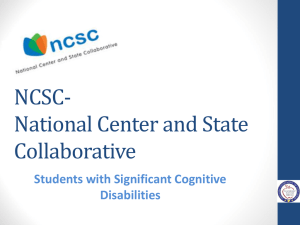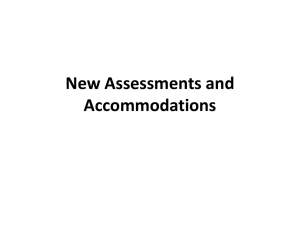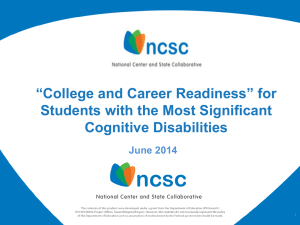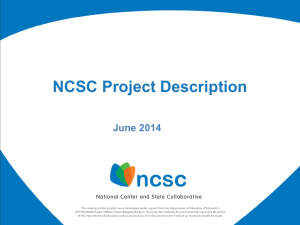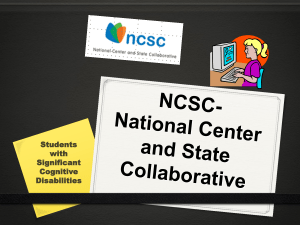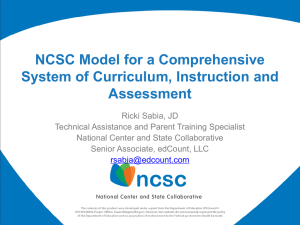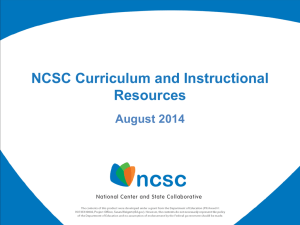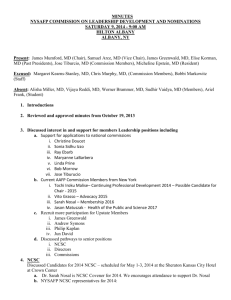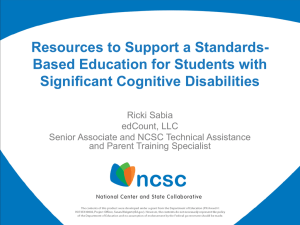NCSC Student Communicative Competence
advertisement
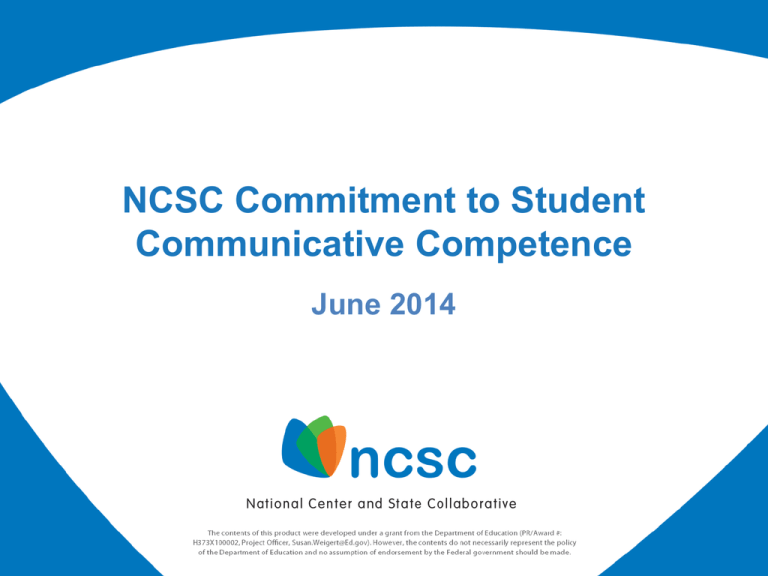
NCSC Commitment to Student Communicative Competence June 2014 Communication Competence Definition • The use of a communication system that allows students to gain and demonstrate knowledge • A “system” may be low tech, no tech, or tech assisted • Many people with severe speech or language problems rely on alternative forms of communication, including augmentative and alternative communication (AAC) systems, to use with existing speech or replace difficult to understand speech Parent Resource on Communicative Competence http://www.ncscpartners.org/resources 3 NCSC’s Commitment to Communicative Competence Document • • • • Discusses NCSC’s beliefs about communication Discusses the role of AAC systems Provides NCSC data about AAC use Describes how the base of the NCSC framework is communicative competence (defined as the use of a communication system that allows students to gain and demonstrate knowledge) • Expresses NCSC’s commitment to helping educators provide an effective way for students to communicate their knowledge and skills Parent Resources • Additional materials designed to help inform parents about NCSC’s work and related issues can be found at http://www.ncscpartners.org/resources • Other topics are: – A summary of the project – The NCSC alternate assessment – The NCSC curriculum/ instructional resources – College and career readiness – Research on instruction/ assessment of students with significant cognitive disabilities 5 NCSC Background Information 6 NCSC Project • In 2010, the U.S. Department of Education awarded the National Center and State Collaborative (NCSC) a grant to develop a new alternate assessment on alternate academic achievement standards (AAAAS) in math and English Language Arts by the 2014-15 school year* • 24 states and five national organizations are working together in NCSC http://www.ncscpartners.org • NCSC is also developing curriculum/instructional resources based on Common Core State Standards (CCSS) that can be used in any state https://wiki.ncscpartners.org * states may have different implementation timelines for NCSC assessment 7 NCSC Communication Beliefs • All individuals communicate regardless of age OR disability. • All output (gestures, cries, noises) can be communicative. • Communication at some level is possible and identifiable for all students regardless of functional “level.” • Every step toward improved communication, attention and interaction leads to increased independence 8 NCSC Communication Beliefs, cont. • Communication goals should increase opportunities for integration and interactions with peers and the community in general. • Students with the most significant disabilities benefit from the interactions with typical peers. • Typical peers benefit from the interactions with students with the most significant disabilities! • No more fundamental outcome of education exists than the right and the ability to communicate. 9 Communication Research 10 Survey of Learner Characteristics for Students Taking an AA-AAS From 18 NCSC States during the 2010-2011 or 20112012 academic year • 69% used symbolic language (verbal or written words, signs, Braille, or language-based augmentative systems) to communicate • Approximately 20% used intentional communication, e.g. consistent patterns of gestures or sounds (emerging symbolic) • Approximately 10% communicated primarily through cries, facial expressions, change in muscle tone (pre-symbolic) 11 Concerning Data on AAC use Only 40% of the students in the emerging or pre-symbolic levels used AAC as part of their educational programs 12 What is AAC? • AAC includes all forms of communication (other than oral speech) used to express thoughts, needs, wants, and ideas. • We all use AAC when we make facial expressions or gestures, use symbols or pictures, or use print. • Special aids, such as picture and symbol communication boards and electronic devices, are available to help people express themselves Effectiveness of AAC • 96% of the studies on use of AAC for individuals with severe intellectual and developmental disabilities over 20 years reported positive changes in some aspects of communication • These findings support communication intervention for students with significant cognitive disabilities • Students with significant cognitive disabilities can learn to use AAC quite quickly • A NCSC report found that most students experienced success with as little as 15 minutes per day of instruction over an average of 6.5 months 14 Importance of AAC Use • AAC provides a method for communication, social interaction, a sense of self-worth and engagement in academics, and other schoolrelated activities (e.g., extra-curricular, workstudy) • AAC prepares students to seek assistance for a variety of situations throughout their lives, including letting someone know if they are suffering abuse and/or neglect. • The ability to effectively communicate reduces the risk that they will be victimized NCSC Commitment to Communicative Competence Career College Community Curriculum Common Standards Learning Progressions Core Content Connectors Instruction Assessment Grade-level Lessons Formative Accommodations Systematic Instruction Summative 17 Communicative Competence NCSC Framework Support for Teachers • A NCSC survey showed that teacher estimates of the reading and communication abilities of students who participate in the AA-AAS were lower than was indicated by learner characteristic data about these students • Teachers and other service providers may need additional training to accurately interpret and increase the communication efforts of students with significant cognitive disabilities • NCSC is committed to helping educators find effective ways for their students to communicate their knowledge and skills
